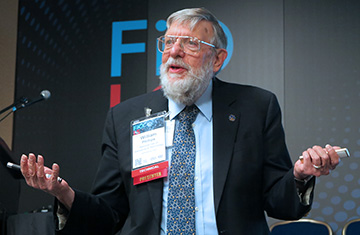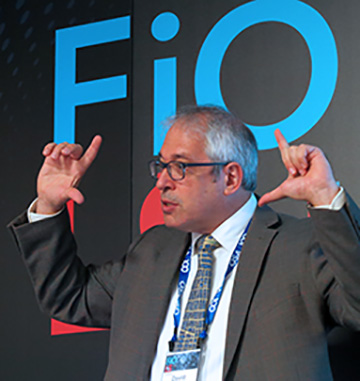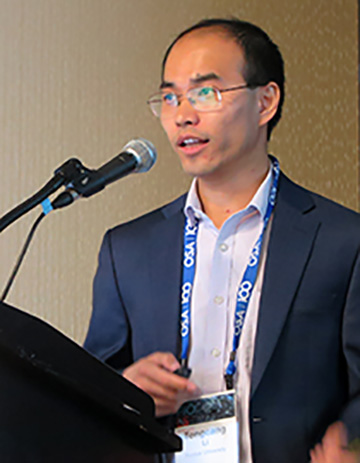
William Phillips at the Nobel Prize symposium at FiO+LS 2019. [Image: Alessia Kirkland]
On the last day of Frontiers in Optics+Laser Science 2019, a special two-part Nobel Prize Symposium explored various research and applications made possible by the two laser advances that were awarded the 2018 Nobel Prize in Physics—optical tweezers and chirped-pulse amplification (CPA).
The physics of optical tweezers
Nobel Prize–winning atomic physicist and OSA Honorary Member William Phillips, National Institute of Standards and Technology (NIST), USA, kicked off the symposium with an enthusiastic presentation on 2018 Nobel laureate and OSA Honorary Member Arthur Ashkin’s invention of optical tweezers. Phillips’ talk shifted the focus from the biological impact of optical tweezers, which was heavily emphasized by the Nobel Prize committee, back to the invention’s roots—atomic physics, where it has also opened up important applications.
Phillips is uniquely qualified to speak to those applications. It was Ashkin’s 1978 paper, “Trapping of atoms by resonance radiation pressure,” that inspired Phillips to study the laser cooling of atoms—for which he himself shared the 1997 Nobel Prize. “In the absence of this paper,” mused Phillips, “maybe there would not have been a Nobel prize in laser cooling.”
In his 1978 paper, Ashkin envisioned trapping atoms with two counter-propagating laser beams. In the following years, he and his colleagues performed ultra-precise levitation and light-scattering experiments, discovering that if the numerical aperture was greater than one, then they were in the “optical-tweezer regime.” These experiments culminated in Ashkin’s 1986 paper, which demonstrated the first atomic optical-tweezer trap.
![]()
[Image: Wikimedia Commons]
Essentially, what Ashkin did was discover that a transparent object (like a living cell or water droplet) is drawn radially toward the most-intense part of a laser beam, and when the object is centered on the laser beam, there is no more radial force and it stays put. “That’s the magic of optical tweezers,” Phillips said. “The object is always moving to the more intense part of the laser beam.”
An enabling technology beyond biology
Phillips closed his presentation with a few examples of modern non-biological advances accomplished using optical tweezers. For example, at Harvard University, USA, Kang-Kuen Ni is “doing chemistry by hand,” building single molecules by guiding two atoms together in a sort of arranged marriage using optical tweezers. This chemistry advance could be significant in physics—single molecules trapped in optical tweezers could conceivably be useful as qubits.
In France, Antoine Browaeys’ group has used optical tweezers to stimulate a topological system, which Phillips described as a realization of the theoretical bosonic Su-Schrieffer-Heeger model. Phillips also cited a recent advance from Gerhard Birkl’s lab in Germany. Birkl used optical tweezers to create perfect 10×10 patterns of single-atom quantum systems—what Phillips described as “using a Maxwell demon to create a low-entropy state.”
“Maybe at some point in the future, we’ll be making quantum computers using optical tweezers,” Phillips said. “And that’s my point—atomic physics has been a wonderful beneficiary of Art’s idea of optical tweezers.”
Tractor beams and nano-rotators

David Grier. [Image: Alessia Kirkland]
Two more invited speakers in the symposium took Phillips’ theme further, exploring the impact of Ashkin’s achievements on work being pursued by their labs today. OSA member David Grier of New York University, USA, looked at how Ashkin’s work with optical tweezers paved the way for thinking about the possible realization of a familiar concept from science fiction—tractor beams, which Grier called “a piece of ‘Star Trek’ technology that Art invented.”
Grier showed work by his lab that uses a detailed mathematical analysis of photokinetic effects to enable the design of “force landscapes” built out of intensity-gradient and phase-gradient forces. The group then uses holographic optical trapping, leveraging tools such as spatial light modulators, to realize these landscapes in the optical domain, and thereby to use the light to exert intricate forces and torques on objects.
These and other holographic techniques, he said, have enabled his group to construct a meter-scale tractor beam—and, he maintains, fundamental scaling relationships raise the possibility of throw lengths a hundred or even a thousand times longer. NASA, for example, hopes someday to use kilometer-scale tractor beams to “pluck dust particles out of comets,” Grier said, adding that similar applications exist in environmental monitoring. And he tied all of this to Ashkin’s work in the 1970s and 1980s. “It all comes from Art,” Grier said.
In another presentation, OSA Senior Member Tongcang Li of Purdue University, USA, presented his lab’s recent work on the optical levitation of nanoparticles. Li and his team have used highly refined optical traps to levitate silica “nanodumbells” in an optical field, and to use them as analogs to a Cavendish torsion balance, sensitive to torques on the order of 10–28 N-m.

Tongcang Li. [Image: Alessia Kirkland]
By applying circularly polarized laser light in the traps, the group has also been able to make these dumbbells spin at frequencies of 1 GHz or more—“more than 100,000 times faster than a high-speed dental drill,” according to Li. The techniques could have applications, he believes, not only in ultrasensitive torque detection but in investigating quantum vacuum fluctuations and in quantum sensing.
CPA’s impact
The symposium’s other invited speaker, OSA Fellow and 2014 President Philip Bucksbaum of Stanford University and the SLAC National Accelerator Laboratory, USA, turned to the enduring impact of the other advance honored in the 2018 Physics Nobel. That advance was chirped-pulse amplification—the invention of which snagged the prize for OSA Fellow and 2013 President Donna Strickland and OSA Fellow and Frederic Ives Medal recipient Gérard Mourou.
Bucksbaum noted that from the beginning, people recognized the “truly remarkable” characteristics of laser light—its coherence, unidirectionality and ability to propagate without spreading, among other thing. “It’s pretty good stuff,” Bucksbaum said. But for 20 years after the invention of the laser, people were trying to find ways to make pulses shorter—and running into the problem of self-focusing and laser damage when they tried.
The solution of that problem by Strickland and Mourou, chirped-pulse amplification, opened up vast horizons in physics, according to Bucksbaum. Almost immediately it was put into service to map out the ionization potential of rare gases. That work in strong-field ionization, in turn, laid down new paths for the generation of short-wavelength radiation. It also created opportunities now being exploited to take science into the attosecond domain, by using the femtosecond beams enabled by CPA to condition electron beams to create attosecond pulses.
The invention also carried considerable weight in the practical realm, Bucksbaum said. He cited examples in precision machining, including the use of femtosecond CPA lasers to create intricate metal and polymer stents for cardiovascular medicine, and the enabling of LASIK surgery, which has been done on 10 million patients in the United States alone.

Philip Bucksbaum. [Image: Alessia Kirkland]
Breaking down the vacuum
Further on the frontiers of discovery, Bucksbaum sketched out the possibilities for exotic science as the high-intensity lasers enabled by CPA approach the “Schwinger limit”—intensities greater than 1029 W/m2. At those extreme intensities, the vacuum field itself—which, Bucksbaum stressed, is not really empty, but contains quantum fluctuations—can be broken down. “That’s an interesting place to be,” he said, and one that raises the possibility of learning about the most energetic places and phenomena in the universe.
“I’ve only described a couple of things,” Bucksbaum stressed, adding that the legacy of CPA will ultimately include “a lot of things we haven’t even thought of yet.” He closed the talk with a simple message to Strickland and Mourou: “Congratulations once again to Donna and Gérard—and thanks for that really great idea.”
In addition to the four invited speakers, shorter talks by three other participants reported specific work growing out of the discoveries of the 2018 Nobel Prize recipients. Neuton Li of the University of Melbourne, Australia, and Justus Ndukaife of Vanderbilt University, USA, touched on aspects of the design and implementation of plasmonic nanotweezers for trapping tiny particles and proteins. And Xinyang Su of Beijing Jiaotong University, China, and the University of Waterloo, Canada, presented work from Nobel laureate Donna Strickland’s lab on a difference frequency generation (DFG)-based source of mid-infrared light—a frequency range increasingly important in environmental and gas sensing.
